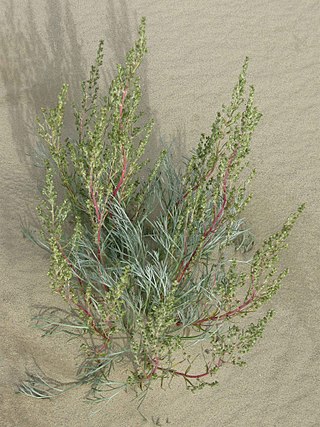
Artemisia is a large, diverse genus of plants belonging to the daisy family Asteraceae, with between 200 and 400 species. Common names for various species in the genus include mugwort, wormwood, and sagebrush.

Artemisia vulgaris, the common mugwort, is a species of flowering plant in the daisy family Asteraceae. It is one of several species in the genus Artemisia commonly known as mugwort, although Artemisia vulgaris is the species most often called mugwort. It is also occasionally known as riverside wormwood, felon herb, chrysanthemum weed, wild wormwood, old Uncle Henry, sailor's tobacco, naughty man, old man, or St. John's plant. Mugworts have been used medicinally and as culinary herbs.

Mugwort is a common name for several species of aromatic flowering plants in the genus Artemisia. In Europe, mugwort most often refers to the species Artemisia vulgaris, or common mugwort. In East Asia the species Artemisia argyi is often called "Chinese mugwort" in the context of traditional Chinese medicine, Ngai Chou in Cantonese or àicǎo (艾草) in Mandarin. Artemisia princeps is a mugwort known in Korea as ssuk (쑥) and in Japan as yomogi (ヨモギ). While other species are sometimes referred to by more specific common names, they may be called simply "mugwort" in many contexts.

Artemisia douglasiana, known as California mugwort, Douglas's sagewort, or dream plant, is a western North American species of aromatic herb in the sunflower family.

Artemisia pycnocephala is a North American species of sagebrush in the sunflower family, known by the common names beach wormwood, sandhill sage, and coastal sagewort.

Artemisia campestris is a common and widespread species of plants in the sunflower family, Asteraceae. It is native to a wide region of Eurasia and North America. Common names include field wormwood, beach wormwood, northern wormwood, Breckland wormwood, boreal wormwood, Canadian wormwood, field sagewort and field mugwort.

Artemisia ludoviciana is a North American species of flowering plant in the daisy family Asteraceae, known by several common names, including silver wormwood, western mugwort, Louisiana wormwood, white sagebrush, lobed cud-weed, prairie sage, and gray sagewort.

Artemisia biennis is a species of sagebrush known by the common name biennial wormwood. It is a common and widely distributed weed, so well established in many places that its region of origin is difficult to ascertain. This species is most likely native to northwestern North America and naturalized in Western Europe, and eastern and southern North America.

Artemisia palmeri is a rare species of sagebrush known by the common names San Diego sagewort and Palmer sagewort.

Artemisia rothrockii is a North American species of sagebrush known by the common names timberline sagebrush and Rothrock's sagebrush.

Artemisia suksdorfii is a North American species of sagebrush in the sunflower family. It is known by the common names coastal mugwort, coastal wormwood, and Suksdorf sagewort. It is native to coastal regions from British Columbia, Washington, Oregon, and northern California as far south as Sonoma County, with isolated populations on Santa Catalina Island in Los Angeles County.

Artemisia borealis is an arctic and alpine species of plant in the sunflower family, commonly known as northern wormwood, boreal sage, boreal wormwood or boreal sagewort. It is native to high latitudes and high elevations in Eurasia and North America. In North America, it can be found in Alaska, Greenland, the Canadian Arctic, and the Rockies, Cascades, and Sierra Nevada as far south as Arizona and New Mexico. In Eurasia, it is widespread across European and Asiatic Russia and also grows in Scandinavia and in the mountains of central Europe

Artemisia cana is a species of sagebrush native to western and central North America; it is a member of the sunflower family. It is known by many common names, including silver sagebrush, sticky sagebrush, silver wormwood, hoary sagebrush, and dwarf sagebrush.

Artemisia norvegica is a species of flowering plant in the aster family known by the common names alpine sagewort, boreal sagewort, mountain sagewort, Norwegian mugwort, arctic wormwood, and spruce wormwood. It is found in cold locations in Eurasia and high altitudes and high latitudes in North America.

Artemisia tilesii is an Asian and North American species of flowering plant in the aster family. Its common names include Tilesius' wormwood, Aleutian mugwort, and stinkweed. It is native to Russia, Japan, and northern North America.

Artemisia stelleriana is an Asian and North American species of plants in the sunflower family. It is native to China, Japan, Korea, Russian Far East, and the Aleutian Islands in the United States. The species is widely cultivated as an ornamental and naturalized in scattered locations in North America, primarily on coastal dunes and other sandy locations, as well as in Scandinavia. Common names include hoary mugwort, Dusty Miller, beach wormwood, and oldwoman.
Artemisia globularia, the purple wormwood, is a rare Asian and North American species of plants in the sunflower family. It is native to Alaska, Yukon Territory, and the Chukotka Autonomous Okrug of Russia.
Artemisia senjavinensis, the arctic wormwood, is a rare Arctic species of plants in the sunflower family. It has been found only on the Seward Peninsula on the Alaskan side of the Bering Strait and on the Chukotka (Chukchi) Peninsula on the Russian side.
Delwiensia is a monotypic genus of flowering plants belonging to the family Asteraceae. The only species is Delwiensia pattersonii, also known as Patterson sagewort or Patterson's wormwood, and formerly Artemisia pattersonii. The species is found in Western Central USA, growing in the Rocky Mountains of Wyoming, Colorado, and New Mexico.

















